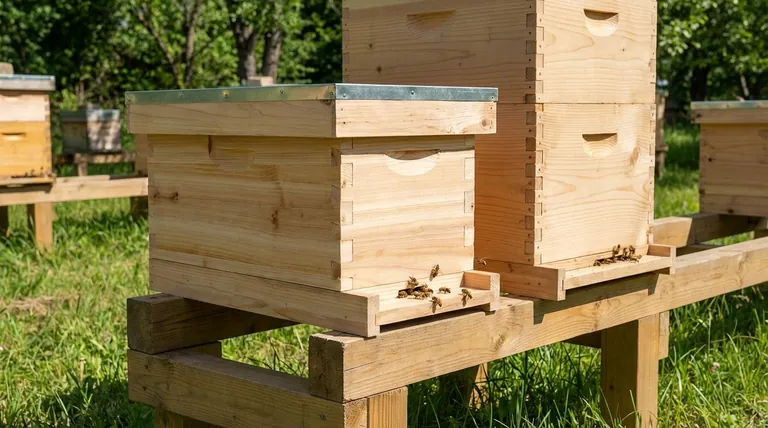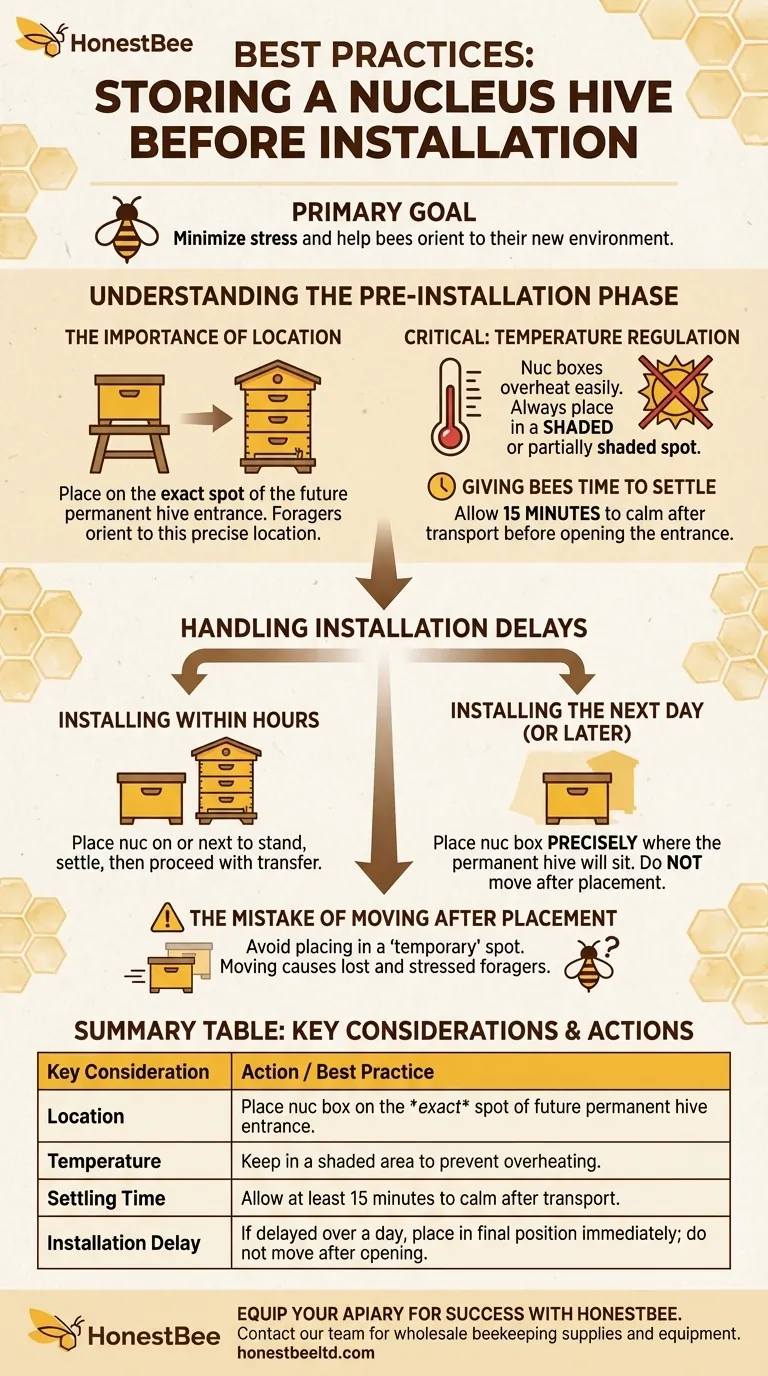Upon arriving at your apiary, you should place the nucleus hive in its final intended location, or as close as possible. Give the bees at least 15 minutes to settle after transport before you open the entrance, and avoid placing the box in direct, prolonged sunlight to prevent overheating.
Your primary goal when storing a nucleus hive is to minimize stress and help the bees orient to their new environment. The storage period, however brief, is the first step in a successful transition to their permanent home.

Understanding the Pre-Installation Phase
A nucleus hive, or "nuc," is a small, vulnerable colony. How you handle it between pickup and installation has a significant impact on its long-term health. The core principles are stability and orientation.
The Importance of Location
When you bring a nuc home, the first foragers will emerge to map their new surroundings. Their internal GPS will lock onto the precise location of that nuc box entrance.
Placing the nuc directly on the hive stand where it will permanently live is the ideal strategy. This ensures that when you transfer the frames into the new hive body, the entrance remains in the same spot, preventing confused and lost foragers.
Critical: Temperature Regulation
Nuc boxes are small and often made of thin plastic or cardboard. They lack the thermal mass and insulation of a full-sized wooden hive.
This makes them highly susceptible to overheating if left in direct sunlight for extended periods. Always place the nuc in a shaded or partially shaded spot, especially during the hottest part of the day.
Giving Bees Time to Settle
Transportation is a stressful and disorienting experience for bees. They are jostled, confined, and subjected to unfamiliar vibrations and sounds.
Allowing the nuc to sit undisturbed for at least 15 minutes before opening the entrance lets the colony calm down. This reduces defensive behavior and allows them to begin reorienting in a more orderly fashion.
Handling Installation Delays
Ideally, you would install the nuc into its permanent hive on the same day you bring it home. However, weather or scheduling conflicts can cause delays.
When Installation is Delayed by a Day or More
If you know you cannot install the nuc for more than a day, it is crucial to position the nuc box exactly where the permanent hive's entrance will be.
The bees will immediately begin foraging and orienting to that location. When you do the installation, you will simply replace the nuc box with the new hive, ensuring the foragers can find their way home.
The Mistake of Moving the Hive After Placement
Do not place the nuc in a "temporary" location for a day and then move it to its final spot a few feet away.
Any foragers who oriented to the temporary spot will return there, becoming lost and stressed. Once you set a nuc down and open the entrance, commit to that location for the installation.
How to Proceed Based on Your Timeline
Your immediate actions should be guided by when you plan to perform the full hive installation.
- If you are installing within a few hours: Place the nuc on or next to the permanent hive stand, let it settle, and then proceed with the transfer.
- If you are installing the next day (or later): Place the nuc box precisely where the permanent hive will sit, ensuring the entrance is in the final desired position.
Ultimately, a calm and stable transition from nuc box to hive is the foundation for a thriving new colony.
Summary Table:
| Key Consideration | Action / Best Practice |
|---|---|
| Location | Place nuc box on the exact spot of the future permanent hive entrance. |
| Temperature | Keep in a shaded area to prevent overheating of the small box. |
| Settling Time | Allow at least 15 minutes for bees to calm down after transport. |
| Installation Delay | If delayed over a day, place in final position immediately; do not move after opening. |
Equip your apiary for success with HONESTBEE.
Setting up a new nucleus colony is just the beginning. Ensuring you have the right, durable equipment is key to long-term beekeeping success. HONESTBEE supplies commercial apiaries and beekeeping equipment distributors with high-quality, wholesale-focused beekeeping supplies and equipment—from full hive bodies and durable frames to essential protective gear.
Let us help you build a stronger operation. Contact our team today to discuss your wholesale supply needs and ensure your bees have the best foundation from the start.
Visual Guide

Related Products
- 5 Frame Wooden Nuc Box for Beekeeping
- Portable Bee Mating Hive Boxes Mini Mating Nucs 8 Frames for Queen Rearing
- HONESTBEE Advanced Ergonomic Stainless Steel Hive Tool for Beekeeping
- Plastic Transporting Bee Packages and Nuc Boxes for Beekeeping
- HONESTBEE Professional Long Handled Hive Tool with Precision Cutting Blade
People Also Ask
- What are the benefits of using nucs for beginning beekeepers? Ensure a Successful First Hive with a Head Start
- How should the nuc be installed in the apiary? Ensure Colony Success from Day One
- What is the advantage of overwintering a nucleus? A Strategic Asset for Beekeeping Success
- What frames should be moved into the queenless hive when requeening with a nuc? Ensure a Successful Queen Introduction
- What is a common feature of many 5-frame nuc boxes? The Integrated Feeder for Efficient Colony Growth



















